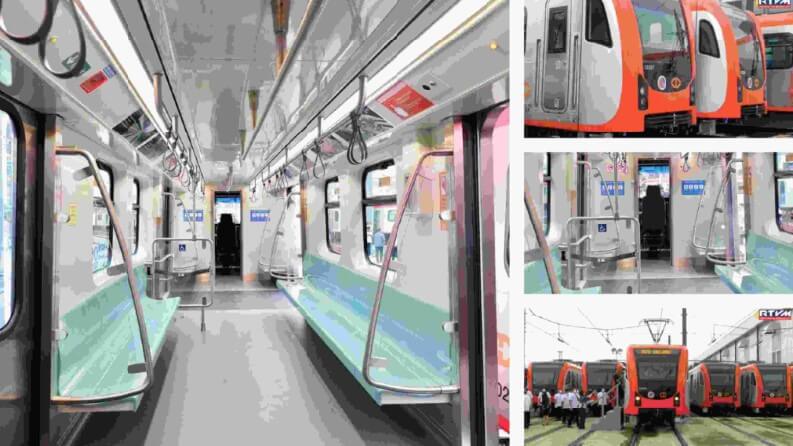
Filipinos can now travel through Metro Manila with the new and improved Light Rail Vehicles (LRVs) aboard the Light Railway Transit Line 1 (LRT-1), a project that seeks to reduce the usage of private vehicles on the road and correspondingly limit air pollution.
The LRV will be a game-changer to the current fleet, as the new train set is a whopping 17 meters longer than the first-generation unit it will replace. “Using a longer train set will increase ridership to 300,000 daily passengers, up from [the] existing 280,000 a day,” Transportation Secretary Jaime Bautista announced during the LRV launch on July 19, 2023.
Beyond this, the train will run faster than the existing vehicles plying the LRT. From the existing speed of 60 kilometers per hour, the fourth-generation train has a maximum speed of 70 kilometers per hour.
“The train’s breaks and signaling system have also been upgraded as enhanced passenger safety features,” Bautista added. “These features will substantially improve operational efficiency so that passenger waiting time between train sets will be reduced to less than 3 minutes.”
The vehicle is dubbed the fourth-generation train in the Philippines, superseding the outdated first-generation train built in 1984. It will run alongside the second-and third-generation trains, respectively constructed in 1999 and 2007.
All of the new LRT train sets have 4 individual light rail vehicles with each car able to accommodate 1,388 passengers per trip. Equipped with destination signs and temperature monitors, the trains will feature enhanced air conditioning. Inside the vehicles, special areas are reserved for PWDs with wheelchairs.
Aside from increasing ridership, speed, and passenger comfort, the vehicles will also prevent accidents on the tracks. “An important new feature is the so-called human-machine interface that allows the train driver to easily troubleshoot and identify possible causes of any operational glitches,” Bautista emphasized.
Great news! @DOTrPH has recently unveiled the new trains plying @officialLRT1. Details in an upcoming story on @GoodNewsPinas_
Source: https://t.co/VlaElxQ2Tw pic.twitter.com/kb1vuZbeda
— Summer Sanares (@scvannasummer) July 24, 2023
World-class transit leader Japan lent its financial support to the project through the Japan International Cooperation Agency. The trains were then created by Mitsubishi Corporation and Construcciones y Auxiliar de Ferrorcarriles (CAF) in Spain and Mexico.
The launch was the culminating product of a two-year trial phase. After the first batch of trains arrived in the Philippines in January 2021, the vehicles underwent a “series of safety checks, inspections, trial runs with minimum kilometers, and acceptance tests”, LRT operator Light Rail Manila Corporation (LRMC) stated.
The inauguration of the new trains was held at the Baclaran Station on July 19, 2023, and passengers were able to board the trains the next day. Thirty new train sets will debut on LRT-1, with one train set per week added to the line until December 2023. However, it will not be until the fourth quarter of 2024 that the trains will be completely deployed, as 10 sets have yet to arrive in the Philippines. All 30 trains are expected to be operational by the opening of the LRT-1 Cavite Extension Project.
The new train was specially made in anticipation of the LRT-1 Cavite extension project. When the project is finished, travel time from Bacoor, Cavite to Baclaran will be reduced to 25 minutes, against the current 1 hour and 10-minute journey. The project will add 8 more stations (11 km in total) to the train system, accommodating about 800,000 commuters daily.
LRT-1 is the Philippines’ first elevated rail system that travels throughout Metro Manila, specifically from Baclaran, Pasay City to Roosevelt, Quezon City. Construction began in 1984, making it the first LRT system in Southeast Asia. At present, it has 20 stations and runs for about 20 kilometers. Over the years, it has been rehabilitated several times due to overcrowding and maintenance issues.
In 2020, the Philippines’ 1st subway system was unveiled. Similarly, in 2019, the Philippine National Railways acquired new trains to shorten the travel time from Laguna to Manila.
Good News Pilipinas is a Lasallian Scholarum Awardee. TELL US your good news story tips by messaging GoodNewsPilipinas.com on Facebook, Twitter, or Instagram, or e-mailing editor@goodnewspilipinas.com
The post Discover the new LRT-1 train upgrading Philippine public transport appeared first on Good News Pilipinas.
Source: Good News Pilipinas
0 Comments